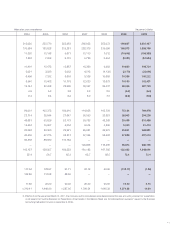Alpine 2009 Annual Report Download - page 21
Download and view the complete annual report
Please find page 21 of the 2009 Alpine annual report below. You can navigate through the pages in the report by either clicking on the pages listed below, or by using the keyword search tool below to find specific information within the annual report.21
determined based on the amounts actuarially calculated using certain
assumptions. The Companies provide allowance for employees’ severance
and retirement benefits based on the estimated amount of projected
benefit obligation and the fair value of the plan assets at the balance sheet
date.
(12) Provision for directors’ retirement benefits
The Company and its domestic consolidated subsidiaries provide for
retirement benefits for directors, based on the bylaws and on the accrual
basis at the balance sheet date.
(13) Provision for product warranties
The Company and certain of its consolidated subsidiaries provide accrued
warranty costs for goods sold based on historical experience of actual
after-sales service costs.
(14) Foreign currency translation
Receivables, payables and investments denominated in foreign currencies
are translated into Japanese yen using the exchange rate at the balance
sheet date, except that investments in unconsolidated subsidiaries and
affiliated companies are translated using the historical rates. The Company
and its domestic subsidiaries include foreign currency translation
adjustments in the net assets in the consolidated balance sheets.
Financial statements of overseas consolidated subsidiaries are translated
into Japanese yen using the year-end rate for assets and liabilities, except
that net assets accounts and investments in unconsolidated subsidiaries
and affiliated companies not on the equity method are translated using
the historical rates. The average exchange rate for the year is used for
translation of income and expenses.
(15) Research and development costs
Research and development costs are charged to income when incurred
and included in costs and expenses.
(16) Income taxes
The Companies recognize tax effects of temporary differences between
the financial statement carrying amounts and the tax basis of assets
and liabilities. The provision for income taxes is computed based on the
pretax income included in the consolidated statements of operations.
The asset and liability approach is used to recognize deferred tax assets
and liabilities for the expected future tax consequences of temporary
differences.
(17) Amounts per share of common stock
Computations of net income per share of common stock are based on the
weighted-average number of shares of common stock outstanding during
each fiscal year.
Diluted net income per share is computed based on the weighted-average
number of common stock and contingent issuance of common stock from
convertible debentures.
Cash dividends per share represent actual amounts applicable to the
respective years.
(18) Software costs
The Company included software in other assets and depreciated it using
the straight-line method over the estimated useful lives (from three to five
years).
(19) Derivative transactions and hedge accounting
The Companies state derivative financial instruments at fair value and
recognize changes in the fair value as gains or losses unless derivative
financial instruments are used for hedging purposes.
If derivative financial instruments are used as hedges and meet certain
hedging criteria, the Companies defer recognition of gains or losses
resulting from changes in fair value of derivative financial instruments until
the related losses or gains on the hedged items are recognized.
(20) Reclassifications
Certain prior year amounts have been reclassified to conform to the 2008
presentation. These changes had no impact on previously reported results
of operations.
(21) Practical Solution on Unification of Accounting Policies
Applied to Foreign Subsidiaries for Consolidated Financial
Statements
Effective from the year ended March 31, 2009, the Company adopted
"Practical Solution on Unification of Accounting Policies Applied to Foreign
Subsidiaries for Consolidated Financial Statements" (Practical Issues Task
Force No.18 (“PITF No.18”) issued by the Accounting Standards Board
of Japan on May 17, 2006) and made the necessary adjustments to the
consolidated financial statements. PITF No. 18 requires that accounting
policies and procedures applied by a parent company and its subsidiaries
to similar transactions and events under similar circumstances should,
in principle, be unified for the preparation of the consolidated financial
statements. PITF No. 18, however, as a tentative measure, allows a parent
company to prepare consolidated financial statements using foreign
subsidiaries’ financial statements prepared in accordance with either
International Financial Reporting Standards or U.S. generally accepted
accounting principles. In this case, adjustments for the following six item
s are required in the consolidation process so that their impacts on net
income are accounted for in accordance with Japanese GAAP unless the
impact is not material.
(a)
Goodwill not subjected to amortization
(b) Actuarial gains and losses of defined benefit plans recognized
outside profit or loss
(c) Capitalized expenditures for research and development activities
(d) Fair value measurement of investment properties, and revaluation of
property, plant and equipment, and intangible assets
(e) Retrospective treatment of a change in accounting policies
(f) Accounting for net income attributable to minority interests
As a result, in comparison to the previous accounting method, operating
loss decreased by ¥68 million (US$692 thousand) and loss before income
taxes and minority interests decreased by ¥75 million (US$764 thousand)
for the fiscal year ended March 31, 2009.
























